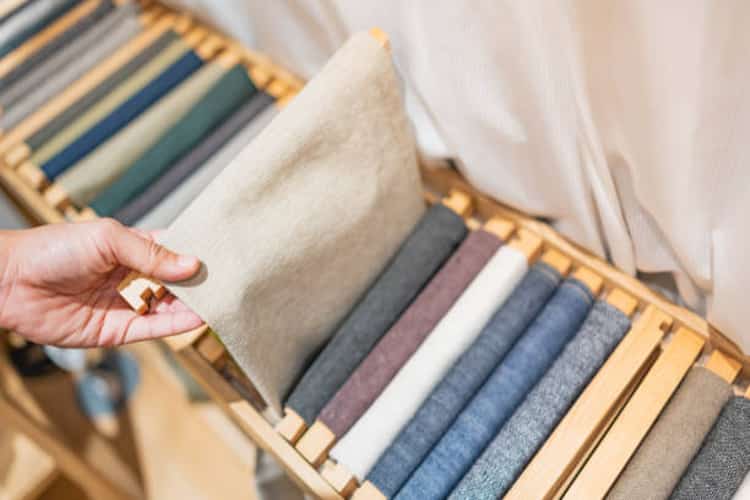
Fabrics are often the most overlooked component of a product’s life cycle. Sustainable fabrics are designed to reduce harm through their production process, fiber properties, and environmental impact.
Textiles comprise 7.7 percent of municipal solid waste in landfills, so shopping for fabrics that don’t hurt the planet or people is essential.
Linen
Linen is an ancient fabric that is gaining popularity among eco-friendly brands. This natural fiber is an excellent option for apparel, bedding, and home goods. It is made from the flax plant and requires little water, pesticides, and fertilizers. This fabric is also biodegradable, making it a sustainable choice for your wardrobe and the environment.
Many organic linen products are now GOTS-certified and free of harmful pesticides and chemicals. However, these fabrics also emit harmful dyeing processes, which can cause negative impacts on the environment. In line with this, many companies are embracing the advancements in sustainable product creation with linen and other products as part of social responsibility.
Another great sustainable option is stonewashed linen. This fabric is made from the flax plant and is breathable, soft, and durable. This fabric is often used to make bath towels, tablecloths, and bed sheets.
Linen is a great fabric for any season, as it can be woven in different styles to suit your needs. Plain-woven linen is commonly found in dishes, cotton towels, and hand towels, but it can also be woven in damask patterns to create decorative items. It is a durable and strong fabric that can be used for years without needing to be replaced.
Cotton
Cotton is a versatile, strong, and durable fiber used in clothing, towels, and sheets. Fiber is also a natural, renewable resource that can be recycled and reused repeatedly. However, conventional cotton production comes with its own set of environmental challenges. It uses a lot of water and pesticides, both harmful to the environment and local communities.
Most cotton crops are grown in dry climates that require much irrigation to grow properly. This, along with the use of pesticides and fertilizers, can cause significant soil and water contamination. Moreover, the cotton industry is often plagued by child slavery and forced labor. This is especially true in developing countries where regulations are lacking, and labor rights are often not enforced.
Another problem is the amount of greenhouse gas emissions from cotton farming. These emissions are released during cotton pickers’ trips to and from the fields and can increase air pollution in nearby areas. Luckily, the sustainable fashion movement has developed techniques to reduce cotton’s negative environmental and planet impact. These methods can include avoiding synthetic dyes and choosing regenerative production processes that recycle cotton waste.
Wool
Wool is a natural and biodegradable fiber that’s used in a wide variety of products. It’s a great choice for clothing, insulation, and even carpets. When you dispose of wool, it will decompose in the soil in months or years, releasing valuable nutrients into the ground. This makes it a great environmental option and a better alternative to synthetic materials. It’s also incredibly breathable and comfortable in hot weather. It can be a thermo-regulating fiber that keeps you warm when cold and cool when warm.
However, wool production is not always ethical and can harm the environment. Sheep are often raised on non-arable land, deforestation is common, and overgrazing can damage fragile landscapes and cause biodiversity loss.
Despite these issues, there are still ethical ways to produce wool. Look for products that follow the Responsible Wool Standard, which requires wool to be raised in a way that protects both the animals and the environment.
Another option is to shop for wool produced from camels, which shed naturally and don’t require chemicals during processing. Yak wool is also a great choice, as it comes from the outer coat or the undercoat of yaks raised free-range on the Tibetan Plateau. Plenty of other sustainable fabrics to consider, including lyocell and Tencel, which are derived from tree pulps and undergo closed-loop processes that are safer for both the environment and humans.
Bamboo
Bamboo has much to offer as a sustainable fabric and can be made into various products. It is a strong, durable, and soft fabric that can be used for garments, towels, bedding, and other household textiles.
However, it is important to be aware of the type of fabric that manufacturers extract from this plant. Some types of bamboo fabric can harm the environment and human health.
Generally speaking, there are two types of bamboo fabrics: rayon and viscose. Rayon is produced by converting wood chips into a chemical solution spun into yarn. This process uses caustic soda (also known as sodium hydroxide) and carbon disulfide, both of which are toxic. These chemicals contribute to air pollution and potentially water pollution, harming workers’ health. They also can cause health complications like chemical burns, nerve damage, and an increased risk of cancer and other diseases.
On the other hand, a more environmentally friendly way to produce this fabric involves a closed-loop process that recaptures and reuses 99% of the chemicals. This type of bamboo fabric is called lyocell, and it is available from many brands, though very few currently use this production method.

